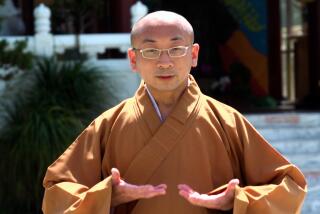Crouching retiree and hidden health benefits in Beijing
BEIJING — It’s late morning at Beijing’s popular Beihai Park, and 72-year-old Han Shusuo is channeling the chimpanzee. Bent double with his gloved hands pressed against the pavement, Han gently lopes forward with a look of serene concentration, his rear end pointed skyward.
“From crawling comes health” is Han’s motto, rooted in his belief that walking upright has made humans more susceptible to illness. Over the last 14 years, he has developed his own brand of martial arts based on the walking patterns of different animals, including chimpanzees, elephants and kangaroos.
Han promotes his craft in Beihai, a thousand-year-old park northwest of the Forbidden City whose emerald lake, weeping willows and meandering paths draw as many as 1,000 retirees every morning.
One might expect to see them engaged in more traditional pursuits: Slow-moving tai chi, perhaps, or calligraphy practice, in which brush strokes of water are applied to the sidewalk, creating beautiful and ephemeral works.
But the boisterous sexagenarians who make up most of the park’s early morning visitors are hardly so tame.
Some play no-holds-barred hacky sack; others sing in groups or dance wildly to rambunctious harmonica jam sessions. But it is the understated Han who commands the most attention.
Many passersby can’t help but stop and stare when they see Han lumbering like a pachyderm or dragging his knuckles.
“Someone once asked me if I was disabled,” he recalls, “but then I jumped up from the ground! They could see I was normal.”
In fact, Han was forced to retire early from his job as a carpenter. At the time, he says, he suffered from spinal and heart problems, muscle pain and high blood pressure. After taking up Shaolin kung fu, a popular form of martial arts that incorporates some poses that imitate animals, he saw no improvement. But it gave him an idea.
“When my diseases got worse,” Han explains, “I decided to go to the zoo and see how animals moved.”
His creativity attracts a certain amount of skeptical attention.
“What do you think you’re doing?” one woman exclaims as she strolls past a group of Han’s students in mid-crawl. “It’s too hot for that kind of thing.”
“Why don’t you go sing instead?” she says, gesturing to a boisterous group under a nearby pagoda. The disciples plod on, unfazed.
“If you’re sick, how can you worry about whether something looks good or bad?” reasons Ding Hongyi, a 68-year-old who started practicing with Han two years ago to combat his diabetes. “I used to weigh 176 pounds, but I lost 20.”
He pats his stomach contentedly. “It’s pretty flat,” he says.
Han credits his trademark “Five Animal Movements” with ending his circulation troubles and helping his spine.
“After a week practicing the animal walks, you can reduce the amount of medication you’re taking,” he claims. “The goal is to not need to take medicine at all.”
More to Read
Sign up for The Wild
We’ll help you find the best places to hike, bike and run, as well as the perfect silent spots for meditation and yoga.
You may occasionally receive promotional content from the Los Angeles Times.




